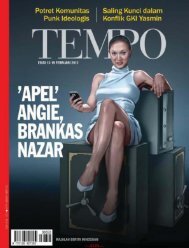3D Creative December 2015
contoh majalah 3dcreative. majalah yang menyajikan trick, tips, dan seni dari teknologi citra 3 Dimensi
contoh majalah 3dcreative. majalah yang menyajikan trick, tips, dan seni dari teknologi citra 3 Dimensi
Create successful ePaper yourself
Turn your PDF publications into a flip-book with our unique Google optimized e-Paper software.
<strong>3D</strong>CREATIVE MAGAZINE | Mastering displacement details<br />
Fabric textures used in<br />
the cloth shaders<br />
Texturing the clothes: The secret to<br />
08 making good cloth shaders, for me,<br />
is to choose a nice fabric texture as a base to<br />
create the bump and diffuse maps. I rarely add<br />
reflections to cloth, only if it’s really visible in<br />
the type of fabric I want to mimic. I usually run<br />
away from very flat and realistic cloth – I really<br />
try to give a quick and exaggerated look to the<br />
fabric, and also try to make the stitch texture not<br />
too tiled. I use many images to make the dirt in<br />
the clothes, but also some texture brushes in<br />
Photoshop with scatter and hue variations. For all<br />
the pockets and leather materials I use a similar<br />
workflow, but with a blurry reflection using the<br />
unsaturated texture as specular map.<br />
Texturing the spray tank models: I’ve<br />
09 developed a very quick shader workflow<br />
for scratched and worn-out metal. I know that<br />
I have to replicate the same shader with little<br />
differences through all the metallic objects, but if<br />
I had to paint all the diffuse, specular and bump<br />
textures for each one separately, it would take<br />
a lot of time. So I create a blend of two shaders:<br />
painted metal and rusted metal. For each slot, I<br />
create a composite shader with a base color using<br />
VRayColor, then tile metal textures with different<br />
opacity values on top of it. I use a normal map<br />
of random noise surface over the metal bump<br />
to make it look more irregular. To blend the two<br />
materials, I paint masks in Photoshop for each<br />
object, and then, if I want to apply the same<br />
shader to another object, I just change the mask<br />
and it works fine.<br />
Basic shader setup: These are some<br />
10 examples of how I set up some of my<br />
shaders mentioned before. The red one is my skin<br />
material; it’s basically a VRayBlendMtl composed<br />
of an SSS2 shader for the skin itself and a VRayMtl<br />
with black diffuse in additive mode for realistic<br />
reflections. I always use the GGX BRDF option<br />
in all of the shaders – this new V-Ray feature<br />
makes the specular more accurate and detailed.<br />
The blue material is the basic metal shader I<br />
use for all metallic objects. The last one is the<br />
Metal shader workflow of the spray tank<br />
Setup of the main shaders I used<br />
cloth shader with a falloff shader applied in the<br />
diffuse slot. I use the falloff between the texture<br />
and a brighter version of the same in order to<br />
mimic the roughness of the surface caused by the<br />
microfibers in the cloth, usually not present in<br />
leather shaders.<br />
<strong>3D</strong>CREATIVEMAG.COM






